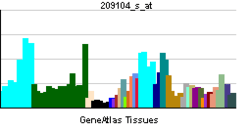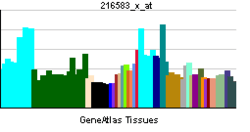NOLA2
| View/Edit Human | View/Edit Mouse |
H/ACA ribonucleoprotein complex subunit 2 is a protein that in humans is encoded by the NHP2 gene.[3][4]
This gene is a member of the H/ACA snoRNPs (small nucleolar ribonucleoproteins) gene family. snoRNPs are involved in various aspects of rRNA processing and modification and have been classified into two families: C/D and H/ACA. The H/ACA snoRNPs also include the DKC1, NOLA1 and NOLA3 proteins. These four H/ACA snoRNP proteins localize to the dense fibrillar components of nucleoli and to coiled (Cajal) bodies in the nucleus. Both 18S rRNA production and rRNA pseudouridylation are impaired if any one of the four proteins is depleted. The four H/ACA snoRNP proteins are also components of the telomerase complex. This gene encodes a protein related to Saccharomyces cerevisiae Nhp2p. Two transcript variants encoding different isoforms have been found for this gene.[4]
References
- ↑ "Human PubMed Reference:".
- ↑ "Mouse PubMed Reference:".
- ↑ Pogacic V, Dragon F, Filipowicz W (Dec 2000). "Human H/ACA small nucleolar RNPs and telomerase share evolutionarily conserved proteins NHP2 and NOP10". Mol Cell Biol. 20 (23): 9028–40. doi:10.1128/MCB.20.23.9028-9040.2000. PMC 86556
 . PMID 11074001.
. PMID 11074001. - 1 2 "Entrez Gene: NOLA2 nucleolar protein family A, member 2 (H/ACA small nucleolar RNPs)".
Further reading
- Henras A, Henry Y, Bousquet-Antonelli C, et al. (1999). "Nhp2p and Nop10p are essential for the function of H/ACA snoRNPs.". EMBO J. 17 (23): 7078–90. doi:10.1093/emboj/17.23.7078. PMC 1171055
 . PMID 9843512.
. PMID 9843512. - "Toward a complete human genome sequence.". Genome Res. 8 (11): 1097–108. 1999. doi:10.1101/gr.8.11.1097. PMID 9847074.
- Zhang QH, Ye M, Wu XY, et al. (2001). "Cloning and functional analysis of cDNAs with open reading frames for 300 previously undefined genes expressed in CD34+ hematopoietic stem/progenitor cells.". Genome Res. 10 (10): 1546–60. doi:10.1101/gr.140200. PMC 310934
 . PMID 11042152.
. PMID 11042152. - Andersen JS, Lyon CE, Fox AH, et al. (2002). "Directed proteomic analysis of the human nucleolus.". Curr. Biol. 12 (1): 1–11. doi:10.1016/S0960-9822(01)00650-9. PMID 11790298.
- Kang HS, Jung HM, Jun DY, et al. (2002). "Expression of the human homologue of the small nucleolar RNA-binding protein NHP2 gene during monocytic differentiation of U937 cells.". Biochim. Biophys. Acta. 1575 (1-3): 31–9. doi:10.1016/s0167-4781(02)00240-3. PMID 12020816.
- Scherl A, Couté Y, Déon C, et al. (2003). "Functional proteomic analysis of human nucleolus.". Mol. Biol. Cell. 13 (11): 4100–9. doi:10.1091/mbc.E02-05-0271. PMC 133617
 . PMID 12429849.
. PMID 12429849. - Strausberg RL, Feingold EA, Grouse LH, et al. (2003). "Generation and initial analysis of more than 15,000 full-length human and mouse cDNA sequences.". Proc. Natl. Acad. Sci. U.S.A. 99 (26): 16899–903. doi:10.1073/pnas.242603899. PMC 139241
 . PMID 12477932.
. PMID 12477932. - Ota T, Suzuki Y, Nishikawa T, et al. (2004). "Complete sequencing and characterization of 21,243 full-length human cDNAs.". Nat. Genet. 36 (1): 40–5. doi:10.1038/ng1285. PMID 14702039.
- Wang C, Meier UT (2005). "Architecture and assembly of mammalian H/ACA small nucleolar and telomerase ribonucleoproteins.". EMBO J. 23 (8): 1857–67. doi:10.1038/sj.emboj.7600181. PMC 394235
 . PMID 15044956.
. PMID 15044956. - Gerhard DS, Wagner L, Feingold EA, et al. (2004). "The status, quality, and expansion of the NIH full-length cDNA project: the Mammalian Gene Collection (MGC).". Genome Res. 14 (10B): 2121–7. doi:10.1101/gr.2596504. PMC 528928
 . PMID 15489334.
. PMID 15489334. - Andersen JS, Lam YW, Leung AK, et al. (2005). "Nucleolar proteome dynamics.". Nature. 433 (7021): 77–83. doi:10.1038/nature03207. PMID 15635413.
- Slizhikova DK, Vinogradova TV, Sverdlov ED (2005). "[The NOLA2 and RPS3A genes as highly informative markers for human squamous cell lung cancer]". Bioorg. Khim. 31 (2): 195–9. PMID 15889794.

